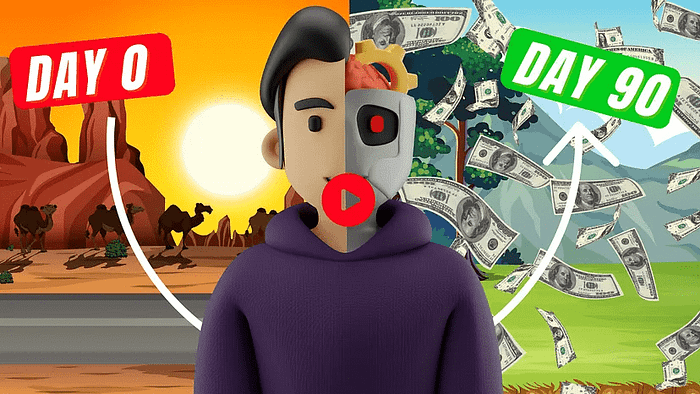How I Compared ChatGPT Pro vs Perplexity AI for Building a $5M Startup
Today I’m going to compare ChatGPT Pro and Perplexity AI for building a $5M startup from scratch.
I’ve been meaning to conduct this experiment for quite some time now, and I’m excited to share my findings with you.
The core question I wanted to answer was straightforward: when you need comprehensive research for developing a business idea, which AI assistant delivers better results?
For context, both platforms offer standard quick-answer capabilities, but their “deep research” functions essentially transform them into something resembling junior analysts—the kind major consulting firms might pay hundreds of thousands annually.
What makes this comparison particularly interesting is the significant price difference: ChatGPT Pro costs $200 monthly while Perplexity offers similar functionality for free or $20/month on their paid tier.
We strongly recommend that you check out our guide on how to take advantage of AI in today’s passive income economy.
Table of Contents
Methodology
I decided to test both platforms by giving them identical prompts focused on creating a viable startup.
My prompt specifically requested an AI agent targeting a high-value niche market, with an emphasis on defensibility.
I asked both tools to create a zero-to-one playbook detailing how to launch and acquire customers, requesting five distinct ideas with corresponding growth strategies.
The financial targets I specified were ambitious but realistic: $1 million in year one, $3 million in year two, and $5 million in year three.
To ensure fairness, I maintained identical constraints across both platforms, including my budget limitations of $55,000 or less for an MVP.
I clarified that while I was primarily interested in cash-flowing the business, I remained open to VC funding if the concept showed potential to exceed $100 million in annual revenue.
Regarding go-to-market strategy, I expressed a preference for viral, self-serve growth models while remaining receptive to alternative recommendations from the AI assistants.
ChatGPT Pro Deep Research Experience
When using ChatGPT Pro’s deep research function, I immediately noticed its thoroughness in qualifying my request.
Before proceeding with the analysis, it asked several clarifying questions about industry preferences, target markets (B2B vs B2C), preferred AI applications, technical resource availability, and go-to-market preferences.
This qualification process, while adding time to the overall experience, helped refine the parameters of my request substantially.
The response time was notably longer—approximately eight minutes for the complete analysis—which might feel substantial if you’re accustomed to rapid AI responses.
However, the depth and comprehensiveness of the results largely justified this wait time, as the output resembled a professional business document rather than a simple response.
What impressed me most was the structural organization of ChatGPT’s response, which presented comprehensive business plans complete with market analysis, defensibility considerations, and detailed growth strategies.
Perplexity AI Deep Research Experience
Perplexity’s deep research function offered a distinctly different experience from the outset.
Unlike ChatGPT, Perplexity didn’t begin with qualification questions, instead proceeding directly to research after receiving my prompt.
I found this approach refreshing, as it allowed me to see the research process unfold in real-time, with Perplexity transparently showing its reasoning model and source collection.
The platform visibly processed information from multiple sources (eventually reaching 34 distinct references), creating a sense of thoroughness despite the more streamlined approach.
Perplexity completed its analysis significantly faster than ChatGPT Pro, delivering results in approximately half the time while maintaining impressive depth in its recommendations.
One amusing discovery during this process was that Perplexity actually cited one of my own YouTube videos as a source, demonstrating its ability to incorporate multimedia content into its research process.
Startup Idea #1: Legal Contract Lifecycle AI Agent (Perplexity)
Perplexity’s first recommendation was a legal contract lifecycle AI agent addressing a substantial pain point: corporate legal teams waste 23% of their time manually reviewing boilerplate contracts while struggling with version control errors that cost enterprises $2.4 billion annually in compliance penalties.
The proposed solution integrated directly with email, SharePoint, and DocuSign via API, learned organizational risk thresholds through historical contract analysis, automatically redlined third-party documents using firm-specific fallback positions, and maintained version lineage with blockchain-style audit trails.
Defensibility factors included developing institutional memory through continuous exposure to negotiation outcomes, becoming deeply embedded in legal department workflows (averaging 14.3 logins per week per user), and requiring substantial retraining equivalent to six to nine months of human experience for any replacement solution.
The growth playbook was structured in three distinct phases, beginning with niche validation (90 days), followed by workflow embedding (months 4-9), and culminating in enterprise scaling (months 10-12).
Phase one recommended building a Chrome extension to record legal contract review sessions (with permission) for training the initial model, while offering free redline audits for 100 AmLaw 200 firms targeting mid-market companies with $50-500 million in revenue.
Initial monetization suggested a $2,500 monthly subscription locked to specific document types, with phase two introducing integration with legal ops platforms, a clause library builder, and usage-based pricing at $0.25 per review clause.
The final phase recommended adding SOC 2 compliance for regulated industries, developing custom connectors for ServiceNow and Salesforce CPQ, and upselling to an $8,000 monthly enterprise tier with custom playbooks.
Startup Idea #1: AI Sales Outreach Assistant (ChatGPT Pro)
ChatGPT Pro’s first recommendation was an AI-powered sales outreach assistant functioning as a virtual SDR (Sales Development Representative) to automate prospect research and personalized outreach across email, calls, and LinkedIn messages.
The target market identified was B2B companies ranging from startups to midsize firms seeking to increase their sales pipeline without hiring additional SDRs.
The defensibility of this concept centered on data network effects, with the AI learning from every interaction to determine which messaging yields replies, building a proprietary dataset of effective approaches for each industry.
This would enable superior personalization and lead scoring tuned to each customer’s context, creating a competitive moat difficult for newcomers to replicate.
ChatGPT Pro particularly emphasized the importance of CRM and email system integration to further strengthen defensibility by embedding the AI directly into sales teams’ workflows.
For MVP development, ChatGPT recommended focusing on a narrow but high-value use case: automating follow-up emails to warm leads using templated but AI-personalized approaches.
The initial product could be a simple web app or Chrome extension where salespeople input prospect lists or connect their CRM, allowing the AI to generate and send personalized emails on a schedule.
To minimize costs, the recommendation included using existing AI APIs (like OpenAI’s GPT), creating a simple interface with low-code tools, focusing initially on email only, and implementing manual fallbacks when the AI expressed uncertainty.
Growth Strategies Comparison
Both platforms provided detailed growth strategies, though their approaches differed significantly in structure and emphasis.
Perplexity offered concise, phase-based growth playbooks with specific timelines, actions, and revenue projections.
ChatGPT Pro provided more extensive growth strategies emphasizing product-led viral adoption, featuring free tiers (50 AI-generated emails monthly) to enable individual sales reps to try the product without requiring management approval.
The ChatGPT recommendation included creative “viral loops” where successful AI-generated meetings would prompt users to share these wins internally, leveraging sales professionals’ natural tendency to share effective tactics.
Both platforms emphasized content marketing, with ChatGPT specifically recommending case studies like “How X Startup Tripled Replies Using AI” and short demonstration videos.
ChatGPT also suggested marketplace presence (HubSpot, etc.) for distribution advantages, targeting a few hundred paying teams within year one, with specific financial projections of 200 companies converting to paid plans at $5,000 annually for $1 million ARR.
Monetization Models
ChatGPT provided more detailed monetization options, including per-seat pricing models ($49/month for solo reps, $199/month for teams of five, enterprise plans for larger organizations) and usage-based tier alternatives.
The platform also explored revenue optimization strategies including premium upsells, annual deals, premium features, and performance-based pricing options.
Perplexity’s monetization recommendations were more integrated with its phase-based growth approach, suggesting specific price points tied to product evolution: $2,500 monthly subscriptions during phase one, $0.25 per review clause during phase two, and $8,000 monthly enterprise tiers during phase three.
Both platforms demonstrated sophisticated understanding of SaaS business models, though ChatGPT provided more extensive discussion of pricing psychology and revenue optimization techniques.
VC Readiness Assessment
An interesting component of ChatGPT’s analysis was its assessment of VC readiness and scaling potential to $100 million ARR.
The platform candidly acknowledged that reaching such scale would likely require venture capital, providing a realistic perspective on growth limitations for bootstrapped businesses.
This section spoke directly to my secondary prompt about potentially raising VC funding if the concept showed $100 million+ potential, demonstrating ChatGPT’s attention to all aspects of my initial requirements.
Perplexity didn’t explicitly address VC readiness, focusing instead on the immediate growth roadmap toward the $5 million target I had specified.
Follow-Up Prompting Experience
To test responsiveness to follow-up questions, I challenged both platforms on their initial recommendations.
With ChatGPT, I questioned whether the AI sales outreach idea might be too common, asking: “I feel like I’ve seen this idea before on social media. How can you take this idea and make it more non-obvious?”
ChatGPT responded by offering to explore underserved niches, combine AI with another trend, incorporate proprietary data, introduce new business models, or enhance viral elements.
When I asked it to decide which approach had the most potential, it developed an entirely new concept: an AI platform for long-tail podcasts and sponsors that would bundle smaller podcasts for advertisers.
With Perplexity, I questioned the viability of the legal AI concept given numerous well-funded competitors, asking for a more differentiated approach while maintaining my $5,000 MVP budget constraint.
Perplexity impressively responded with an executive summary analyzing 37 funded competitors, identifying three underdefended market niches, and providing a competitive differentiation matrix.
It then detailed a Chrome extension prototype implementation plan with a precise $4,800 budget, followed by feature rollout phases and go-to-market sequencing information.
Cost-Value Analysis
The pricing difference between these platforms raises an important question: is ChatGPT Pro worth ten times the price of Perplexity’s offering?
ChatGPT Pro ($200/month) delivered more comprehensive, document-style responses with extensive market analysis, implementation details, and strategic considerations.
Perplexity (free for limited uses, $20/month for unlimited) provided concise, actionable recommendations with excellent structured data presentation (tables, matrices) and faster response times.
The value proposition ultimately depends on your workflow preferences and research needs—ChatGPT excels at comprehensive “one-shot” responses requiring minimal follow-up, while Perplexity delivers faster results that might require additional prompting for comparable depth.
For many users, Perplexity’s free tier provides exceptional value, especially for occasional deep research needs, while frequent users might find either paid option justifiable depending on their specific requirements.
Conclusion
Both ChatGPT Pro and Perplexity AI demonstrate remarkable capabilities in developing sophisticated business strategies and startup concepts.
The quality of output from both platforms was genuinely impressive—”scary good” in terms of strategic insight, market understanding, and implementation planning.
If you’re developing a startup concept or business strategy, incorporating either of these deep research tools into your workflow seems almost mandatory given the competitive advantage they provide.
For those prioritizing comprehensive first-pass responses with minimal follow-up requirements, ChatGPT Pro’s more thorough qualification process and extensive outputs may justify its premium pricing.
Users who prefer faster turnaround times and are comfortable with iterative prompting might find Perplexity’s more concise, visualization-friendly format preferable, especially given its significantly lower cost.
The most pragmatic approach might be experimenting with both platforms to determine which better complements your working style, strategic thinking process, and budget constraints.
Regardless of which platform you choose, these AI research assistants represent a fundamental shift in business planning capabilities, democratizing access to strategic insights previously available only through expensive consulting engagements.
Implementing AI Research in Your Startup Process
Whether you’re brainstorming new ventures or refining existing business models, incorporating AI deep research tools can significantly accelerate your strategic development process.
The key advantage these tools provide isn’t merely information aggregation but rather the synthesis of disparate data points into coherent, actionable business frameworks.
When using either platform, I recommend beginning with broad conceptual prompts before gradually refining parameters based on initial responses.
This approach allows the AI to explore creative possibilities while ultimately converging on strategically viable concepts aligned with your specific constraints and objectives.
For optimal results, provide clear parameters regarding target markets, budget limitations, revenue goals, and competitive differentiation requirements.
Remember that while these tools provide remarkable strategic frameworks, the ultimate responsibility for validation, refinement, and execution remains with you as the entrepreneur.
Use these AI-generated concepts as sophisticated starting points rather than definitive business plans, applying your industry knowledge, network relationships, and entrepreneurial instincts to evolve promising concepts into viable ventures.
The most effective approach combines AI-powered research breadth with human-driven strategic depth—leveraging technological capabilities while maintaining the creative vision that defines truly innovative businesses.
Click Here to Download:10 AI-generated startup ideas worth millions

We strongly recommend that you check out our guide on how to take advantage of AI in today’s passive income economy.




